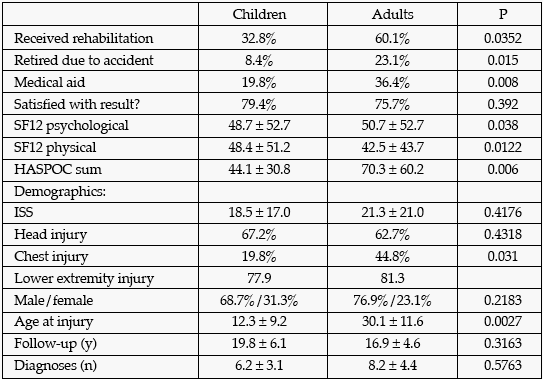
Sat., 10/18/08 Foot & Ankle/Pediatrics, Paper #66, 12:29 pm OTA-2008
Will Younger Turn Out Better? Differences in Outcome between Children and Adults More Than Ten Years after Polytrauma
Christian Probst, MD1 (a-Grant by H & S Re Insurance Company, Grant from Medartis, Basel, Switzerland);
Martin Panzica, MD1 (a-Grant by H & S Re Insurance Company); Boris A. Zelle, MD2 (n);
Ralf Lohse, MD, PhD3 (e-H & S Re Insurance Company);
Nicola A. Sitarro, MD3 (H & S Re Insurance Company);
Christian Krettek, MD1 (a-AO Foundation);
Hans-Christoph Pape, MD2 (a-AO Foundation, Grant by H & S Re Insurance Company);
1Department of Trauma, Hannover Medical School, Hannover, Germany;
2Department of Orthopaedic Surgery, University of Pittsburgh, Pittsburgh, Pennsylvania, USA;
3Hannover Re, Hannover, Germany
Hypothesis: Physiologic, anatomic, and psychosocial specifics in children are generally believed to turn life for the better in severely injured children when compared to adults. Yet very long-term outcome of children after polytrauma in comparison to adults remains unknown. We examined the long-term physical and psychological outcome in children and adults with comparable injuries more than 10 years after the trauma.
Methods: We assessed 637 polytrauma patients between 3 and 60 years (children: n = 131, 20.6%, age 3-17, mean = 12.3 years; adults: n = 506, 79.4%, age 18-60, mean=30.1 years) treated at our Level 1 trauma center with a minimum of 10 years of follow-up (mean children: 19.8 ± 4.7 years vs adults: 16.9 ± 4.8 years) after the trauma for their rehabilitation status and quality of life including Hannover Score for Polytrauma Outcome (HASPOC), Short Form 12 (SF-12) and other parameters. Patients answered a questionnaire and were physically examined by a surgeon.
Results: Children showed better physical rehabilitation (SF-12 physical, HASPOC) with less use of medical aids and early retirements despite fewer rehabilitation therapies and comparable ISS. Yet the psychological score of children is worse in comparison to adults. Nonetheless, both groups feel well rehabilitated (Table).

Conclusion: We conclude that children do better than adults in the physical components of everyday life, while they seem to be more impaired on the psychological side. Also, since fewer children received rehabilitation treatment, they seem to have highly effective intrinsic mechanisms of physical recovery.
Relevance: Prevention of a long-term reduction of psychological quality of life despite successful physical rehabilitation may need special attention in pediatric multiple trauma patients.
If noted, the author indicates something of value received. The codes are identified as a-research or institutional support; b-miscellaneous funding; c-royalties; d-stock options; e-consultant or employee; n-no conflicts disclosed, and *disclosure not available at time of printing.
• The FDA has not cleared this drug and/or medical device for the use described in this presentation (i.e., the drug or medical device is being discussed for an “off label” use). ◆FDA information not available at time of printing. Δ OTA Grant.